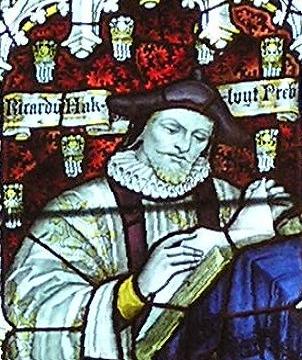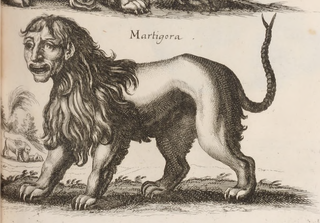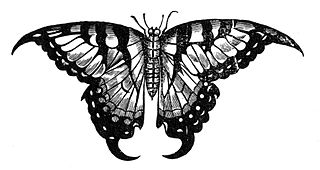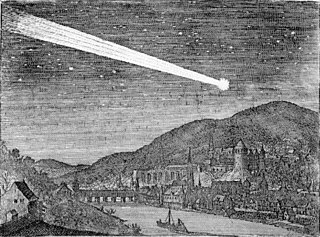Related Research Articles

1607 (MDCVII) was a common year starting on Monday of the Gregorian calendar and a common year starting on Thursday of the Julian calendar, the 1607th year of the Common Era (CE) and Anno Domini (AD) designations, the 607th year of the 2nd millennium, the 7th year of the 17th century, and the 8th year of the 1600s decade. As of the start of 1607, the Gregorian calendar was 10 days ahead of the Julian calendar, which remained in localized use until 1923.

Simon Marius was a German astronomer. He was born in Gunzenhausen, near Nuremberg, but spent most of his life in the city of Ansbach. He is best known for being among the first observers of the four largest moons of Jupiter, and his publication of his discovery led to charges of plagiarism.

Richard Hakluyt was an English writer. He is known for promoting the English colonization of North America through his works, notably Divers Voyages Touching the Discoverie of America (1582) and The Principal Navigations, Voyages, Traffiques and Discoveries of the English Nation (1589–1600).

The manticore or mantichore is a Persian legendary creature similar to the Egyptian sphinx that proliferated in Western European medieval art as well. It has the head of a human, the body of a lion, and the tail of a scorpion or a tail covered in venomous spines similar to porcupine quills. There are some accounts that the spines can be launched like arrows. It eats its victims whole, using its three rows of teeth, and leaves no bones behind.

Bartholomew Gosnold was an English barrister, explorer and privateer who was instrumental in founding the Virginia Company in London and Jamestown in colonial America. He led the first recorded European expedition to Cape Cod. He is considered by Preservation Virginia to be the "prime mover of the colonization of Virginia".
The year 1705 in science and technology involved some significant events.
The year 1608 in science and technology involved some significant events.
The year 1572 in science and technology included many events, some of which are listed here.
Edward Maria Wingfield, sometimes hyphenated as Edward-Maria Wingfield was a soldier, Member of Parliament (1593), and English colonist in America. He was the son of Thomas Maria Wingfield, and the grandson of Richard Wingfield.
John Brereton was a gentleman adventurer, clergyman, and chronicler of the 1602 voyage to the New World led by Bartholomew Gosnold.

Edward Topsell was an English cleric and author best remembered for his bestiary.

Marino Ghetaldi was a Ragusan scientist. A mathematician and physicist who studied in Italy, England and Belgium, his best results are mainly in physics, especially optics, and mathematics. He was one of the few students of François Viète and friend of Giovanni Camillo Glorioso.
Events from the 1600s in England. This decade marks the end of the Elizabethan era with the beginning of the Jacobean era and the Stuart period.
Historia animalium, published in Zurich in 1551–1558 and 1587, is an encyclopedic "inventory of renaissance zoology" by Conrad Gessner (1516–1565). Gessner was a medical doctor and professor at the Carolinum in Zürich, the precursor of the University of Zurich. The Historia animalium, after Aristotle's work of the same name, is the first modern zoological work that attempts to describe all the animals known, and the first bibliography of natural history writings. The five volumes of natural history of animals cover more than 4500 pages. The animals are presented in alphabetical order, marking the change from Middle Ages encyclopedias, or "mirrors" to a modern view of a consultation work.
The year 1535 in science and technology included a number of events, some of which are listed here.
The year 1545 in science and technology involved some significant events.

Thomas Boreman was one of the earliest English children's book publishers particularly dealing with animals. His bookshops were located around London

The Discourse on Comets was a pamphlet published in 1619 with Mario Guiducci as the named author, though in reality it was mostly the work of Galileo Galilei. In it Galileo conjectured that comets were not physical bodies but atmospheric effects like the aurora borealis.
Gabriel Archer was an early explorer who became a settler at Jamestown. He explored Cape Cod with Bartholomew Gosnold before going in the first wave of settlers to Jamestown in 1607. At Jamestown, he clashed with John Smith repeatedly before eventually dying in the winter of 1609-1610, also known as the Starving Time. The Jamestown Rediscovery Project, among other scholars, considers the possibility that Gabriel Archer may have been a Catholic, based on how he was buried.
References
- ↑ Stoyan, Ronald (2015). Atlas of Great Comets. Cambridge University Press. p. 63. ISBN 9781316195727.
- ↑ Omodeo, Pietro Daniel (2014). Copernicus in the Cultural Debates of the Renaissance: Reception, Legacy, Transformation. BRILL. p. 141. ISBN 9789004254503.
- ↑ Walsh, Robert (1828). The American Quarterly Review. Carey, Lea & Carey. p. 494.
- ↑ "The familiar and the fantastic: The historie of foure-footed beastes by Edward Topsell, 1607". Royal College of Surgeons. Retrieved 3 April 2018.
- ↑ "The Galileo Project". galileo.rice.edu. Retrieved 3 April 2018.
- ↑ "The Theater that was Rome - Biography". library.brown.edu. Retrieved 3 April 2018.
- ↑ "Bartholomew Gosnold - English explorer". Encyclopedia Britannica. Retrieved 3 April 2018.
- ↑ "Georg Bartisch (1535-1607)". data.bnf.fr. Retrieved 3 April 2018.